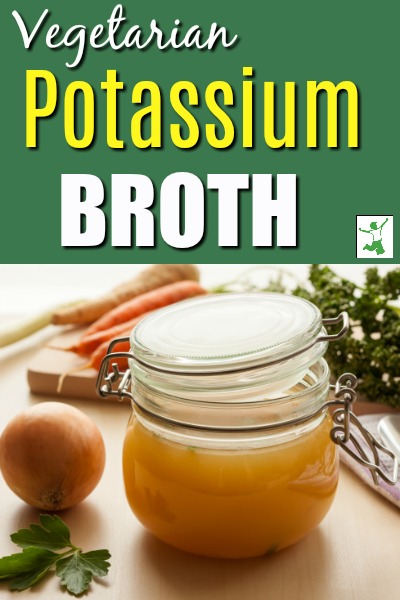Table of Contents[Hide][Show]

After the births of my second and third children, I was fortunate enough to have a number of friends with extensive knowledge of traditional food preparation bring my family meals until I was back on my feet. In addition to enjoying the benefits of bone broth and nutrient-dense meals, potassium broth was one of the most helpful tonics these caring friends made sure I had in the refrigerator to help me recover very quickly.
Potassium Broth Benefits
Potassium broth is best sipped warm like tea. It is an incredible rejuvenator! When a tablespoon of liquid whey is stirred into each cup, it assists digestion and absorption of the copious amounts of potassium and other minerals present in the broth. The liquid whey also adds enzymes and probiotics.
Potassium broth is an excellent present to bring to a dear friend after she’s had a baby. It is also a wonderful tonic for someone who has recently had surgery or suffered an extended illness.
I’m often asked what is the best thing to bring to a relative in the hospital. Without a doubt, homemade soups and Potassium broth in a thermos top the list! It is easy to load up a small cooler with 3 or more thermoses for the days’ meals. Liquids stay warm in a thermos for many hours. I have not found a nurse that objects to a small cooler by a patient’s bedside.
One other excellent use for potassium broth for pregnant and newly postpartum moms. It is fantastic for eliminating issues with leg cramps at night. People sometimes suffer from these as they get older as well. A mason jar of this tonic in the refrigerator for sipping at night before bed is a great home remedy for this problem.
Another dish that is perfect for recovery is Kitchari porridge. Of course, the healthiest bone broth loaded with gelatin is a wonderful food to offer as well. Potassium broth is much quicker to make, however. It is also a good option for friends/relatives who are vegetarian.
How to Make Potassium Broth
Potatoes are nightshade vegetables. As a result, be sure to use very fresh, preferably organic potatoes in this recipe. They should never be green under the skin or have any visible sprouts, as this could add the toxin solanine to the potassium broth.
Inspired by the recipe in Nourishing Traditions Cookbook.

Potassium Broth Recipe
Recipe for homemade potassium broth that is an excellent tonic postpartum or for those recovering from surgery or illness in the hospital
Ingredients
- 4 potatoes well scrubbed, preferably organic
- 3 carrots peeled, chopped, preferably organic
- 4 celery stalks chopped, preferably organic
- 1 bunch parsley preferably organic
- 4 quarts filtered water
- 1 Tbl liquid whey
Instructions
-
Peel potatoes. Place the potato peelings, carrots and celery in a large pot with the filtered water. Bring to a boil, reduce heat and simmer for 30 minutes. Add parsley and simmer for 5 more minutes.
-
Cool and strain the finished potassium broth into glass containers in the refrigerator, reheating small amounts as needed. Add 1 TBL whey to each cup for a big boost to mineral assimilation.
-
Potassium broth freezes beautifully, so freeze what you will not use in about one week.
Recipe Notes
Potassium broth lasts about 4 days in the refrigerator. Freeze what you will not use in that time.
The cooked and strained veggies are ideally tossed into the compost bin (all the minerals are in the broth!).









Hi there, can you speed up the thickening of the milk to make whey by adding freshly squeezed lemon juise or vinegar? I have perefiral neuropathy of my feet and read somewhere that potassium broth is good for you. Kind regards Marie
I love this recipe! I also added beet greens to my recipe and made it in the instant pot. It came out delicious!
Hi Sarah, thanks for your recipe. My doctor just recommended I get started immediately on this broth! Please help! I cannot seem to get my hands on “liquid” whey protien. Can I use regular whey protien as a substitute? ?
Powdered whey protein is a damaging food … it is highly processed and very difficult to digest. It cannot be used in this recipe. Liquid whey is a whole food. It is the clear liquid that you see in a container of plain yogurt when you open it. You can make it yourself using one of these 2 tutorials. Very easy!
https://www.thehealthyhomeeconomist.com/separating-whey-plain-store-yogurt/
https://www.thehealthyhomeeconomist.com/video-liquid-whey-and-cream-cheese/
What is “liquid” whey
It is the clear liquid that typically is at the top of cultured dairy products like yogurt.
I was hoping your recipe would be clearer than that in NT. But, your recipe is a verbatim copy of Sally’s. Can you tell me, when the recipe says “peelings”….. does it mean all the peelings or just the potato peelings? I love NT, but the recipes are not always very clear.
Just the potato peelings.
If I make this recipe without the whey, how much does that lower the potassium content? Thank you.
I can not have whey, is there something else I could substitute with?
How much potassium is in one cup? Thanks!
It would depend on the quality of the vegetables that you use to make it. Also different potatoes have different potassium content. Get the best quality you can afford, preferably organically grown in soil (not hydroponic).
This time of year I can get new potatoes at the Farmer’s Market. They can be quite small, are there lbs or a size recommended for the potatoes. Don’t want to over do it, but what it to be adequate.
Thanks.
Use any potato you like. In season from the Farmers Market sounds perfect!
I have what might seem like a silly question. Is the broth made with the whole vegetable or the peels? Or both? What do you do with the vegetables once strained away?
I know I’m deficient in potassium and would like to make this for a pre-bedtime drink. TIA
Just use the peelings of the potatoes. For the peeled carrots (discard the peel) and celery, chop them and use whole thing. Compost the discarded veggies after you strain them.